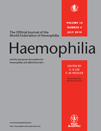Recombinant activated factor VII safety and efficacy in the treatment of cranial haemorrhage in patients with congenital haemophilia with inhibitors: an analysis of the Hemophilia and Thrombosis Research Society Registry (2004–2008)
Abstract
Summary. Cranial haemorrhage (CH) is a potentially serious complication in patients with severe congenital haemophilia with inhibitors (CHwI). Treatment includes bypassing agents, such as recombinant activated factor VII (rFVIIa). To examine the US experience in treating CH with rFVIIa, a retrospective review of the Hemophilia and Thrombosis Research Society 2004–2008 database was conducted. Among 29 patients with CHwI, 56 of the reported haemorrhages met the study criteria. Of these, 75% were traumatic and 80% were extracranial (ECH). The majority (8/11, 73%) of intracranial haemorrhages (ICHs) developed spontaneously. Conversely, most ECHs (39/45, 87%) followed trauma. ICHs were treated with a median/mean of 23/58 rFVIIa infusions over a median/mean of 7/9 days while ECHs were treated with a median/mean of 1/3 infusions (P = 0.011) over a median/mean of 1/1 day. The median/mean initial rFVIIa doses for all CHs were 106/137 μg kg−1, and were similar for ICHs and ECHs. All ECHs were effectively controlled with rFVIIa; 44/45 bleeds were controlled within 24 h, one bleed was successfully treated perioperatively, and 27 ECHs required only a single dose. Nine out of 11 ICHs were effectively treated with rFVIIa; six ICHs were controlled within 24 h, one within 72 h and in two cases haemostasis was achieved during the perioperative period. No serious treatment-associated adverse events were reported. One patient died as a result of ICH despite the reported control of bleeding. In conclusion, standard dosing of rFVIIa was found to be safe and effective in treating CH with an efficacy rate of 100% for ECH and 82% for ICH.




